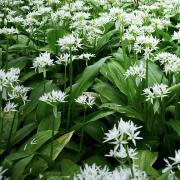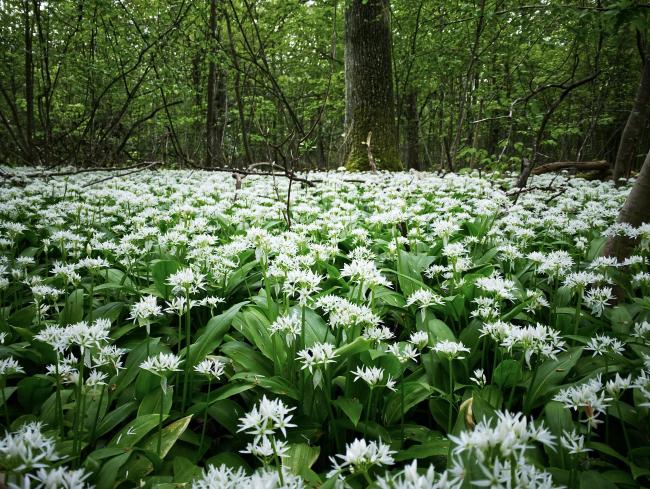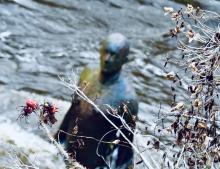
There may not be a massive variety, but Edinburgh offers plenty of ‘food for free’, to use a term popularised by Richard Mabey in his 1972 book on foraging.
In the autumn, Blackberries are ubiquitous along paths and on hillsides.
In the spring, shady and damp conditions such as those found along the Water of Leith walkway are ideal for wild garlic (Allium ursinum), whose unmistakeable and pungent aroma fills the air here.
Wild garlic spreads vigorously along certain sections of the walkway, for example between Dean Village and Belford Bridge. Given the number of dogs which frequent this route, I’d recommend seeking out areas of growth further up the banks or in other places less likely to have ‘fertilised’.
Picking the right species
In early spring, it can, initially, be difficult to differentiate between wild garlic and snowdrops. The lighter, more vibrant green of the garlic should soon become obvious.
More importantly, you need to make sure that you differentiate the garlic from the poisonous lily of the valley (Convallaria majalis), which also likes shaded areas. The main clue is that lily of the valley does not smell like garlic! Wild garlic also becomes translucent when you rub it. For those who are unsure, plant identifier apps such as PictureThis will help.
Picking the right way
As mild weather starts, the garlic suddenly bursts into life. From a few tentative shoots in late February, it grows rapidly. April and May are probably the best months to eat it, as by June it starts to gently rot.
It’s rather different from the cloves of artichoke and silverskin garlic we are used to. Not only in its physical form but in its smell, which has strong onion/spring onion notes. In a pesto, it can replace basil or rocket as the core green ingredient.
To pick it, I would suggest taking a pair of scissors or knife and cutting at the stem, so that you avoid uprooting it and bringing home large clumps of soil. Alternatively, focus on picking one leaf at a time, not great clumps, which may contain other plants intertwined.
In terms of responsible foraging, you should pick from areas where there is a plentiful supply, and then take only a small amount for yourself. Foragers should never completely strip an area, as this could damage the species and deny other foragers the chance to collect. In short, don't damage habitats and leave enough for wildlife.
Pesto than all the rest
Even if you do manage to take home a relatively clean bunch, you really need to wash it thoroughly. You just don't know what and who has been in contact with it. I would recommend soaking it in the sink and washing it at least twice, perhaps finishing off in a salad spinner.
You really want to focus on the leaves, though the flowers and seed pods are also edible. Before blitzing, I’d add toasted pine nuts, a squeeze of lemon juice, Parmesan/Pecorino cheese and a generous glug of extra virgin olive oil. Season with salt and pepper.
The quality of the oil is so important. Top-quality extra virgin oil really raises the level of the pesto substantially, but is an expensive business. It is worth it. When you add in the cost of the oil and things like pine nuts, it admittedly eats away at the idea of food for free. We should perhaps focus on the sheer freshness of the ‘free’ food, not its cost.
In terms of pasta, I’d suggest linguine or spaghetti. After cooking the pasta al dente, make sure you are generous with the amount of pesto you stir into it. Serve with a final grating of cheese and another drizzle of oil. The pesto is also excellent on toast and drizzled into soups.
Foraging forays
Last year we had several successful foraging forays along riverbanks. The very best crop we came across was not in Edinburgh, but picked from the banks of the White Cart Water in Pollok Country Park. The walkway there very much supports the idea of Glasgow as a ‘dear green place’, easily matching the Water of Leith walkway for bucolic charm. The wild garlic we found there had a greater depth of flavour. Perhaps it was just that it had sweated in a carrier bag all the way back to Edinburgh in a stuffy train!
Wherever you pick your wild garlic from, you should be able to enjoy a number of delicious bowls of pasta between now and June. But do forage responsibly, being mindful of others who may wish to use it and the need to ensure that the garlic regenerates.—Charlie Ellis
Charlie Ellis is a researcher and EFL teacher who writes on culture, education and politics.
[Photo by Timo C. Dinger on Unsplash.]




